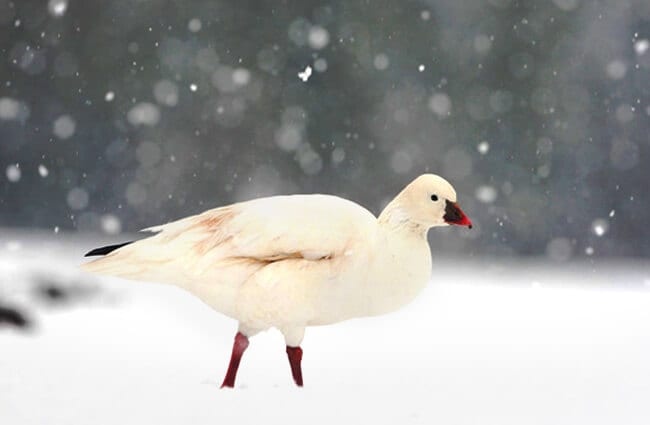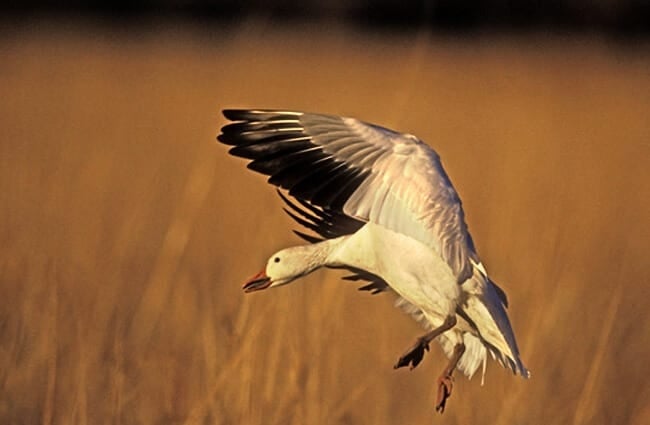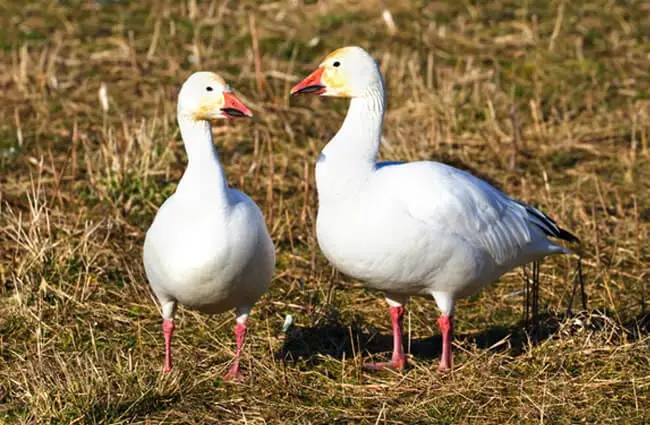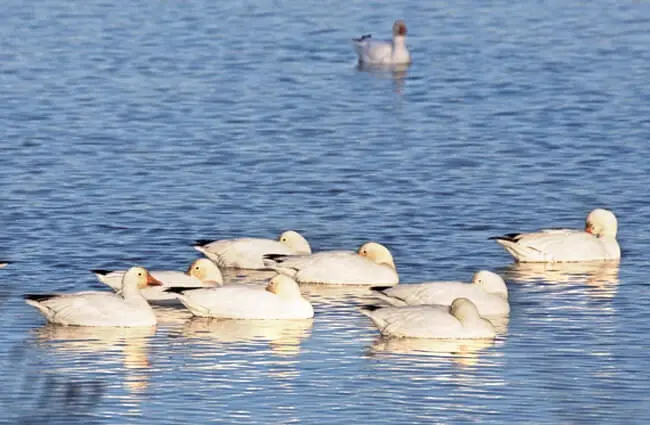An Introduction to the Majestic Snow Goose
The Snow Goose, a stunning bird of the Arctic and sub-Arctic regions of North America, is a familiar sight to many birdwatchers and nature enthusiasts. Its graceful flight, striking plumage, and large communal gatherings make it a truly captivating species. This guide delves into the fascinating world of the Snow Goose, exploring its habitat, behavior, life cycle, ecological role, and its relationship with humans. Whether you are a seasoned ornithologist, a budding zoologist, or simply curious about these magnificent creatures, this article offers a comprehensive look at the Snow Goose.

Physical Characteristics and Distinctive Plumage
Snow Geese are large birds, typically measuring between 28 to 36 inches in length and boasting a wingspan of over 5 feet. They are aptly named, with most individuals exhibiting pure white plumage over much of their body. Adults develop black primary flight feathers. These are visible during flight and are a key identifying characteristic. Interestingly, there are two distinct color morphs. The white morph, which is more common, and the ‘blue’ morph, where the body plumage exhibits a greyish‑blue tinge. The blue morph is believed to be linked to a single gene and is more prevalent in certain populations, like those breeding in Wrangel Island, Alaska.
Both sexes appear similar, though males are typically slightly larger than females. Young birds, known as goslings, are covered in greyish-down and gradually develop white plumage as they mature. A distinctive feature of all geese, including the Snow Goose, is the pinkish‑red bill, often with a black tip, and legs and feet are pinkish‑red.
Habitat and Distribution
Snow Geese breed primarily in the high Arctic regions of North America, including parts of Canada, Alaska, and Russia. They favor coastal plains, tundra, and areas near lakes and rivers, providing suitable nesting grounds. During the winter months, these migratory birds travel south, congregating in warmer climates. Major wintering grounds include the Central Flyway, stretching from the Gulf Coast of the United States to Mexico, and the Pacific Flyway, extending along the west coast of North America. Significant populations also winter in the Sacramento Valley of California and along the Gulf Coast of Texas and Louisiana. The choice of wintering location is often influenced by food availability and milder weather conditions.

Diet and Foraging Behavior
Snow Geese are primarily herbivores, with their diet consisting of grasses, sedges, grains, and agricultural crops. During the breeding season, they feed on newly emerging vegetation in the tundra. In winter, they often graze on agricultural fields, consuming leftover grains and grasses. They are also known to feed on eelgrass in coastal areas. Their feeding behavior is often communal, with large flocks grazing together. They use their strong bills to uproot plants and consume both the above‑ground and below‑ground portions. Snow Geese are highly adaptable feeders, able to exploit a variety of food sources depending on availability.
Life Cycle: Reproduction and Development
Snow Geese are monogamous birds, typically forming long‑term pair bonds. They return to the same breeding grounds year after year, often reusing the same nest sites. Nesting typically occurs in late spring or early summer. Nests are constructed on the ground, usually on elevated areas with good visibility, and are made of vegetation, such as grasses and mosses. The female lays between three to six eggs, which are incubated for approximately 25 to 30 days. Both parents participate in incubation, with the female taking the primary role.
Goslings are precocial, meaning they are relatively well‑developed at birth and are able to walk and feed themselves shortly after hatching. Both parents care for the goslings, protecting them from predators and guiding them to food sources. Goslings grow rapidly and are typically able to fly at around 50 to 60 days old. They often migrate with their parents, learning the routes and wintering grounds.

Social Behavior and Flocking
Snow Geese are highly social birds, often congregating in large flocks, known as ‘skeins’ during migration and ‘gaggles’ when on the ground. These large gatherings provide protection from predators and facilitate efficient foraging. During the breeding season, Snow Geese form colonies, with multiple nests located close together. Communication within flocks is achieved through a variety of vocalizations, including honking, hissing, and trumpeting. These calls are used to maintain contact, warn of danger, and coordinate movements. Their coordinated flight formations are a spectacular sight, often involving precise maneuvering and synchronized wingbeats.
Ecological Role and Interactions
Snow Geese play an important role in the ecosystems they inhabit. As herbivores, they influence vegetation patterns and nutrient cycling. Their grazing can help maintain the health of grasslands and prevent the encroachment of woody vegetation. Their droppings contribute to soil fertility, providing essential nutrients for plant growth. Snow Geese also serve as prey for predators, such as foxes, wolves, and eagles. They have complex interactions with other bird species, sometimes competing for food resources and nesting sites. They often share foraging grounds with other waterfowl species, creating a diverse and dynamic ecosystem.
Human Interactions and Conservation Status
Snow Geese have a long history of interaction with humans. Historically, they were hunted for their meat, eggs, and feathers. Hunting remains a regulated activity in many areas, providing a source of food and recreation. However, overhunting and habitat loss have posed threats to Snow Goose populations in the past. Currently, the species is not considered globally threatened, with a large and stable population. However, certain populations, particularly those breeding in Wrangel Island, Alaska, have experienced rapid growth, leading to concerns about overgrazing and habitat degradation in their wintering grounds.

Identifying Snow Geese in the Wild
If you are fortunate enough to encounter Snow Geese in the wild, here are a few tips for identification. Look for large, white birds with black primary flight feathers. Pay attention to their distinctive honking calls. Observe their behavior, such as grazing in fields or flying in coordinated flocks. Note the color of their legs and feet, which are typically pinkish‑red. If you are observing a flock, look for the presence of both white and blue morph individuals. Observing these details will help you confidently identify these magnificent birds.
For Zookeepers and Animal Care Professionals
Caring for Snow Geese in captivity requires a thorough understanding of their natural history and behavioral needs. Provide a spacious enclosure with access to both land and water. The diet should consist of a variety of high‑quality waterfowl feeds, supplemented with fresh greens and grains. Regular health checks and veterinary care are essential. Provide opportunities for social interaction with other Snow Geese or compatible waterfowl species. Avoid overcrowding and provide ample space for foraging and nesting. Enrichment activities, such as providing puzzle feeders or introducing novel objects, can help stimulate their natural behaviors. Strict biosecurity measures should be implemented to prevent the spread of disease.
Evolutionary History and Subspecies
The evolutionary history of the Snow Goose traces back to the Anserinae subfamily within the Anatidae family, which includes all swans, geese, and ducks. Fossil records suggest that ancestral geese emerged during the Miocene epoch, around 23 to 5 million years ago. The Snow Goose, as a distinct species, likely evolved from these ancestral forms, adapting to the harsh conditions of the Arctic tundra. Two subspecies are generally recognized: Anser caerulescens caerulescens (the Greater Snow Goose) and Anser caerulescens gambeli (the Lesser Snow Goose). The Lesser Snow Goose is generally smaller and breeds further inland, while the Greater Snow Goose is larger and more often found near coastal areas.

Fun Facts about Snow Geese
- The Snow Goose is a powerful flyer, capable of reaching speeds over 60 miles per hour during migration.
- Goslings can swim shortly after hatching, allowing them to navigate open water and ponds early in life.
- Snow Geese are known for their long‑distance migrations, often traveling thousands of miles each year.
The Snow Goose remains a captivating symbol of the Arctic wilderness. Its resilience, social behavior, and majestic flight continue to inspire awe and wonder in all who observe it. By understanding and appreciating this remarkable species, we can ensure its continued survival for generations to come.

![Red Angus Closeup of a beautiful Red Angus cowPhoto by: U.S. Department of Agriculture [pubic domain]https://creativecommons.org/licenses/by/2.0/](https://animals.net/wp-content/uploads/2020/03/Red-Angus-4-238x178.jpg)




![Red Angus Closeup of a beautiful Red Angus cowPhoto by: U.S. Department of Agriculture [pubic domain]https://creativecommons.org/licenses/by/2.0/](https://animals.net/wp-content/uploads/2020/03/Red-Angus-4-100x75.jpg)

